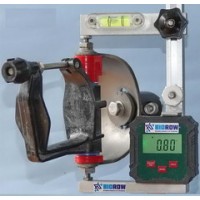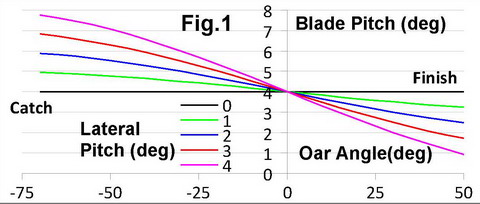Blade pitch adjustment

Effective bladework depends on the blade pitch – the angle between the vertical and the blade (measured at a certain cross-section) during the drive, which depends on three components:
- The blade pitch relative to the load plate of the sleeve is usually set by manufacturers (standard 0o) and can hardly be changed by the user.
- The gate pitch is the angle between its load plate and the pin, which can be adjusted using plastic inserts supplied with the oarlock and remains constant during the drive. Usually set at 4o.
- The pitch of the pin is the most complicated component, it can be measured in frontal (fore-aft pitch) and transverse (lateral pitch) planes. The pin pitch affects the gate and blade pitches during the drive, varying them. The following rules apply:
A lateral pin pitch creates unidirectional changes to the blade pitch during the drive, So, the lateral pitch can help to maintain optimal blade depth at variations in the handle force vector direction, caused by changes in the rower’s body geometry during the drive (RBN 2010/09).

E.g., at a standard gate pitch of 4o and lateral pin pitch of 2o out, the blade pitch from catch to finish will be 5.7o-4.0o-3.0o (Fig.1, 60o-0o-30o oar angles). After the catch, more blade pitch would help to prevent extensive blade submersion, when the force vector has an upwards component from the handle, higher towards the shoulders. Before the finish, less blade pitch would prevent the blade “washing out”, when the force vector is nearly horizontal, towards the elbow located at the same or even lower in height relative to the handle.
The fore-aft pitch of the pin results in either a convex or concave curve of the blade pitch during the drive. Say, at an aft pin pitch of 2o and gate pitch of 4o, the blade pitch would be 4.5o-6.0o–5.0o from the catch – to the finish, so the blade would jump up and down during the drive. Therefore, it is recommended to set fore-aft pin pitch to 0o, to neutralize its effect.
The boat rotations (RBN 2012/03) affect the pin pitch, so and blade pitch. At the catch, the boat pitch is positive (bow – up), so it increases the pin fore-aft pitch, but affects the blade pitch less, because it is rotated away from the transverse plane. At a typical 1o boat pitch at the catch and 60o oar angle, the effect on the blade pitch would be only 0.5o. At the finish, the boat pitch is negative and has lower values: at a typical boat pitch of -0.5o at the fore and oar angle of 35o, it decreases the blade pitch by a negligible 0.2o. In fact, the boat pitch has the same effect as the lateral pitch at the pin: slightly increasing the blade pitch at the catch, while decreasing it at the finish. Therefore, in singles, where the boat pitch is more significant (1.5o amplitude), the lateral pitch could be set at lower values of 1 -1.5o, while in big boats with less boat pitch (0.8o) the lateral pin pitch could be more significant, up to 2-3o.
The boat roll doesn’t affect the blade pitch, when the oar is perpendicular to the boat (in the transverse plane), but may affect it significantly at the catch and finish. E.g., if the boat rolls by -3o after the catch (port side – down, common in sculling, RBN 2011/07) at 60o oar angles, the pitch at the portside blade is increased by 1.5o and decreased by the same amount on the starboard. More blade pitch applies an upward force component on the lowered port gate, and opposite down force on the raised starboard, so after the catch the blade pitch creates rotating momentum opposite to the boat roll and creates a stabilizing effect on the boat. At the finish, the effect is opposite, but smaller: the blade pitch creates momentum in the same direction with the boat roll, tending to increase it and destabilize the boat. Therefore, it is important to minimise the boat roll before the finish to provide a clean blade exit and avoid “catching crabs”.
BioRow can help you with rigging in a number of ways. Recently we developed an electronic Pitch Meter for the pin (Fig.2), which allows precise adjustment of important pin angles. More information can be found here: Biorow Pitch Meters Product Sheet

Also, BioRow rigging services can help you to measure and analyse your rigging, discuss it with you and help to rig you boats and oars in the most optimal way. More info here: Biorow Rigging Services
©2022 Dr. Valery Kleshnev www.biorow.com



